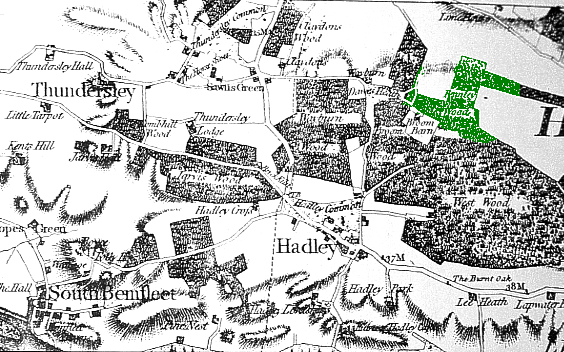In the map above, Pound Wood is shown under its old name of Fenley Wood. This map is originally from Chapman & André, published in the late eighteenth century, but taken here from Rackham, 1986. The Fenley Wood area is shown in dark green.
Roman Times
Most of these woods described by Rackham occur on the edges of the Rayleigh Hills which stretch from Leigh through Thundersley and Rayleigh to Hockley and Ashingdon. From about 100BC, Iron Age and later Romano-British farmers probably cleared and settled most of the lowlands between these hills and the riverside marshes, leaving the higher ground as wildwood. The latter provided hunting land, fuel and building materials and so played just as significant a role in the local economy as did the fields on the lower lands. There is evidence that clearings in the woods were made and aerial photographs suggest that a Roman-style villa may have existed in the fields to the north of Pound Wood. It is impossible to tell whether Pound Wood was then part of the wildwood or if all or part of the site was villa pasture and the wood developed in Saxon or Medieval times after the villa was abandoned.
The Saxons
The Roman occupation of Britain finally ended when troops were withdrawn in 409AD. Left unprotected, Essex increasingly came under attack from Saxon raiding parties sailing up the Thames and Crouch estuaries. It is likely that by the 6th or 7th centuries the Saxons, with very little resistance, had settled down and built villages in S.E. Essex, probably pushing further into the wildwood than had the Romano-British farmers.
Settlements in the hills have names ending in leah, an Anglo-Saxon word meaning ‘clearing‘. It is therefore likely that villages such as Hadleigh, Thundersley, Rayleigh and Hockley (then much smaller than they are today) were established in clearings in the wildwood. A few Saxon names for some of these woods survive to appear on old maps and Horseley wood (part of Hadleigh Great Wood), Goldingsley (part of Belfairs Wood) and Tilehurst (the old name for Tile Wood — hyrst means a wood on a hill) are all close to Pound Wood. Tilehurst may have been named after some forgotten association with tiles. Could it have been a deposit of old Roman tiles and bricks the remains of the villa north of Pound Wood?
The Middle Ages
Through the Middle Ages this area remained well wooded and provided fuel and building materials in abundance. The Church owned many of the woods in the Hadleigh–Thundersley area: the Dean and Chapter of Westminster Abbey owned Pound Wood and Tile Wood and St Paul‘s Cathedral owned West Wood. Large wooded areas were often sub-divided into individual possessions owned by different landowners. St Paul’s Cathedral owned Dodd‘s Grove and parts of Hadleigh Great Wood as did Prittlewell Priory.
The boundaries of these individual possessions were marked by digging ditches and constructing earth banks through and around the woods. The remains of these banks and ditches can still be seen today. The boundary banks of Pound Wood probably date back to Anglo-Saxon or early Medieval times. The southwestern part of Pound Wood is outside the main boundary bank and is therefore probably a later extension to the wooded area into a neighbouring field. A late Medieval and an 18th century bank mark the borders, confirming that this extension to the wood is itself very old.
It is estimated that a mile of wood bank would have taken over 5000 man-hours of digging. The woodbanks of Pound Wood therefore represent well in excess of this amount of work and reflect the importance of marking ownership and preventing unwanted livestock from entering the wood and nibbling saplings and new coppice growth. This emphasises the value of these woods to their owners.
The 13th to 19th Centuries
Since the 13th century, Pound Wood had been the property of the Dean and Chapter of Westminster Abbey, and was transferred to the Church Commissioners in 1875. Lease books in Westminster Abbey appear to have confused Pound Wood with nearby Tile Wood but boundary descriptions make clear that Pound Wood was, at various times, known as Tyler’s Wood and Wolf’s Wood. The name Pound Wood first appeared on a note in the Hadleigh Parish Register which records that a lessee known as Mr Johnson had been felling in Pound Wood in 1750. The name was used in a lease of 1769 and was repeated on all leases through to 1862. The origin of the name Pound Wood remains a mystery as, to date, no references to either a pound or pinfold in the area has been found and no person named Pound appears in any record.
Pound Wood continued to supply timber, firewood and charcoal over the centuries but we have little specific information on the area.
In the 18th century the area was still much more heavily wooded than today and Pound Wood was part of a larger wooded area named Fennley which extended further north across Eastwood Old Road. The name Fennley in Anglo-Saxon suggests ‘boggy place’, a description confirmed by a Westminster Abbey surveyor who described their state in 1759 as ‘a dirty spot, inaccessible to carriages except in frosty weather’.
These extensive woods with a few scattered and isolated farmsteads made this a lonely and wild district. It was notorious as a bleak and muddy area, difficult to traverse and noted for its smugglers and robbers. The main settlements of Hadleigh and Thundersley (then tiny villages) lay several miles away to the south and west respectively.
Daws Heath (possibly named after Philip Dawe who held the land 700 years ago) was a triangular patch of open heathland, just to the south-west of Pound Wood and was used for grazing the few animals of the poor local farm workers and, from the 16th Century, for charcoal burning. In the mid-18th Century one or two poor squatters built illegal cottages on the heath and enclosed small plots for gardens. Then, between 1792 and 1804, the landowner encouraged the enclosure of a further 15 acres and a more planned settlement of cottages and gardens covered the heath, establishing the hamlet of Daws Heath which, although it attempted to gain independence in 1835, remains part of the parish of Thundersley.
The Modern Setting
Pound Wood was bounded by four farms, two of which survive today. To the west is Tylerset Farm which, along with Pound Wood and Tile Wood, formed a 92 acre estate which belonged to Westminster Abbey. The present house, set back off Daws Heath Road, consists of two cottages combined, and may be some 300 years old. The land was last used for pigs and market garden produce but since 1981 has been let as horse pasture.
To the south lay Haresland in a clearing between Pound Wood and the now felled Coxall Wood. This farm lay at the far end of the present housing estate of Haresland Close off Bramble Road. To the east was Garrolds, a 51 acre farm which now supports horses after pig production ceased in the early 1980s.
To the north, in what are now abandoned pastures between Pound Wood and Eastwood Old Road lay Bretts or Haggetts. There are records of a farmhouse with barn and stables here in 1711 but by the mid 19th century the land was rented by Haresland Farm and the buildings had disappeared.
The first half of the 19th century saw the removal of much of the woodland between Pound Wood and Hadleigh, although Dodd’s Grove and Belfairs Nature reserves survive. Today the relatively poor soils and the small size of the farm units make crop tillage or livestock husbandry uneconomical and farming has ceased. A housing estate now covers the land to the south and pastures to the north have been abandoned. Tylerset Farm and Garrolds Farm now provide pasture for the ‘horsiculture’ so common in the urban fringe areas of S.E. Essex today.
Pound Wood itself continued to be used as a source of timber into this century but its importance declined. A complaint made in 1935 by a Rector of Thundersley that Pound Wood was suffering rubbish dumping and use by gypsies and vagrants bears testimony to this.
In 1920 the War Department paid £107s6d compensation for the destruction of trees and undergrowth when trenches were dug in connection with the defence of London during the First World War. No trace of these trenches can he seen today; the dells or pits to be found in Pound Wood are probably abandoned gravel pits which date from a much earlier time.
Pound Wood Today
The wood, no longer significant as a source of income, was to be sold by the Church Commissioners for low density housing under a Rochford Rural District Council plan of 1929, but fortunately this scheme came to nothing, as did a plan by British Airways to build executive housing on nearby Lower Wyburns Farm should Maplin Airport be developed. Pound Wood and adjacent land was thus saved from joining the suburban development which today reaches right up to its southern boundary, and now has Green Belt status. The purchase of the wood by the Essex Wildlife Trust in 1993, helped by the generous donations of many local people, has ensured its survival into the future. Lower Wyburns Farm has become the site of a new Little Haven Children’s Hospice, with some 100 acres of woods and meadowland west of Pound Wood being managed by the Trust as the Little Haven Nature Reserve. More recently, the Trust has acquired what was then called Cottage Plantation (now called Valerie Wells Wood) just south of the Little Haven reserve. Pound Wood has thus entered the 21st century as part of a complex of Daws Heath Nature Reserves, managed for wildlife and quiet enjoyment by the public.
Bob Delderfield’s History Files
Editor’s Note: These are a series of articles taken from the Pound Wood Newsletter and its successors. They are available through the Newsletters page in the Tree at the top.

